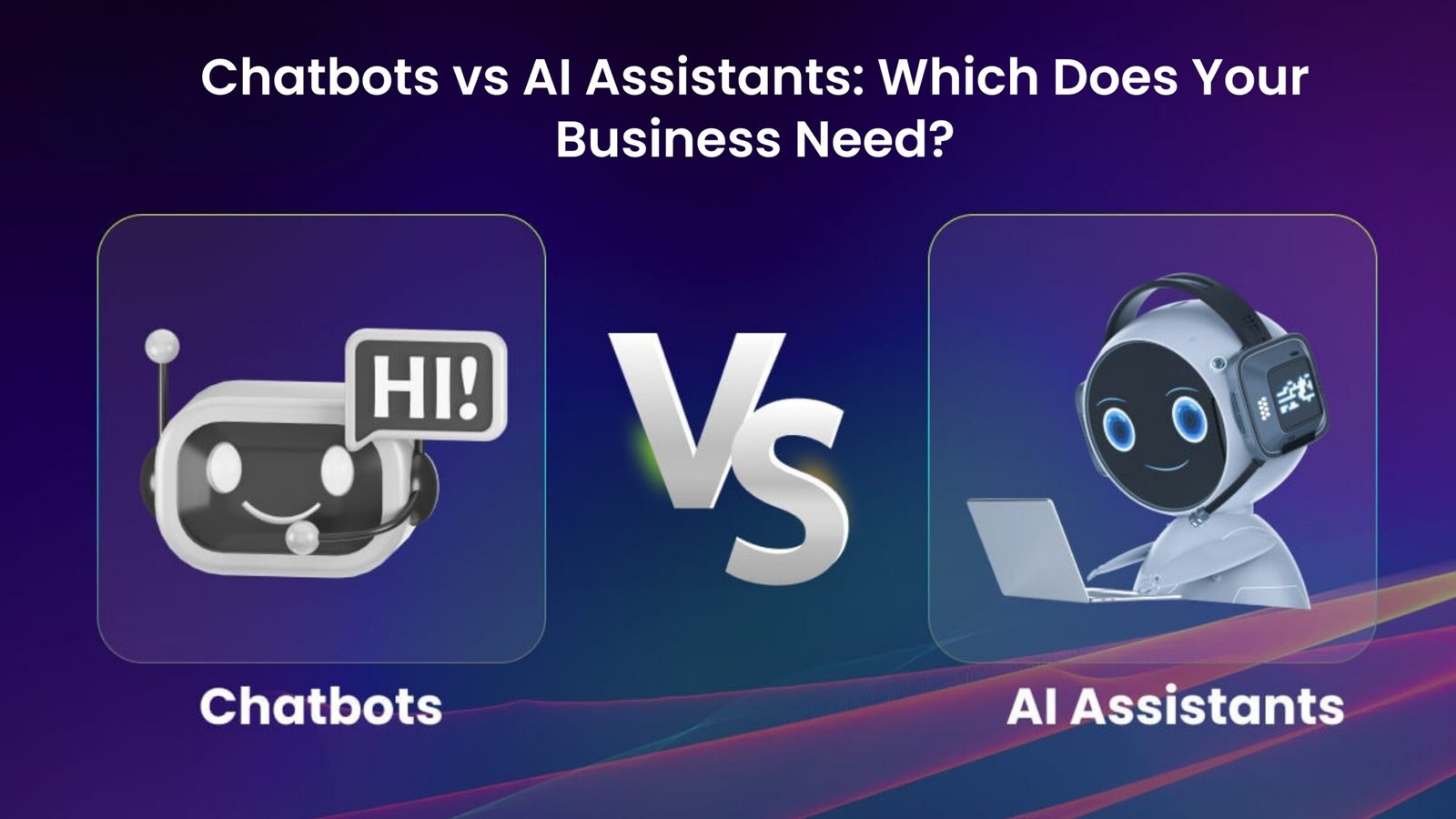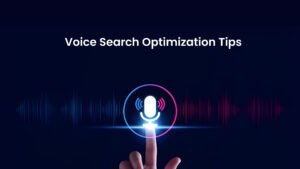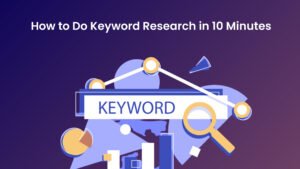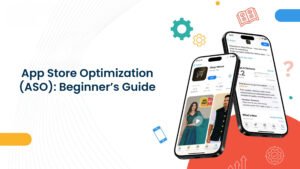Introduction
Customer expectations have shifted dramatically. People now want instant answers, personalized interactions, and consistent support across every channel. For business leaders, this pressure translates into a simple but challenging question: how do you deliver faster, smarter, and more efficient customer service without inflating costs?
AI customer service has stepped in as a powerful solution. Businesses today are exploring two main approaches: AI chatbots and AI assistants. While both seem similar at first glance, they solve very different problems. The choice between a chatbot and a virtual assistant can shape how your company handles growth, scales customer support, and builds brand loyalty.
Think about it this way. A customer has a basic question about their order status. A chatbot can handle that in seconds. But when a customer needs personalized recommendations, troubleshooting, or even scheduling help, that is where AI assistants take over. Understanding the difference is no longer a technical detail. It is a leadership decision that impacts customer satisfaction, operational costs, and ultimately revenue.
This article will break down the chatbot vs virtual assistant debate, highlight where each technology fits, share real-world use cases, and give you a roadmap for implementation. By the end, you will have a clear picture of which solution your business really needs and how to measure its long-term impact.
Understanding the Basics
What is an AI Chatbot
An AI chatbot is designed to simulate a conversation with customers, usually through a website, mobile app, or messaging platform. Its primary job is to answer repetitive questions, guide users through standard processes, and keep support queues clear for more complex issues.
Most chatbot tools today rely on Natural Language Processing to understand customer queries and respond in real time. They work well in handling structured requests such as:
-
Checking order status
-
Providing store hours or policies
-
Directing customers to relevant knowledge base articles
-
Capturing lead details for sales teams
Industries such as eCommerce, banking, healthcare, and travel have widely adopted AI chatbots. For example, an online store may use a chatbot to handle shipping queries or refund requests, reducing the burden on human agents. Banks deploy chatbots to answer account balance questions instantly without requiring a call center executive.
The strength of chatbots lies in efficiency. They are quick, consistent, and available around the clock. However, they often struggle when faced with open-ended or complex queries that require judgment, memory of past interactions, or multi-step problem solving.
What is an AI Assistant
AI assistants, sometimes called virtual assistants, go beyond scripted interactions. They are designed to handle context-rich conversations and support decision-making tasks. Instead of simply answering a question, an AI assistant can understand intent, process multiple layers of information, and act on behalf of the user.
An AI assistant does not just respond—it integrates with business systems like CRM, ERP, or scheduling tools to perform tasks such as:
-
Offering personalized product or service recommendations
-
Booking meetings and sending reminders
-
Managing customer onboarding workflows
-
Providing multilingual support in real time
-
Assisting employees with data insights and task automation
Unlike basic chatbots, AI assistants learn over time. They analyze patterns in customer behavior, adapt responses, and can even predict what a customer might ask next. For example, an airline’s AI assistant could not only confirm a booking but also proactively offer check-in services, baggage policies, and personalized travel upgrades.
The key difference is that AI assistants function more like digital team members than automated response systems. They are capable of becoming strategic assets in customer service and business operations.
Chatbot vs Virtual Assistant: Key Differences
At first glance, AI chatbots and AI assistants may seem interchangeable. Both engage customers through digital channels, both use artificial intelligence to respond, and both reduce the load on human teams. But the reality is that their scope, capabilities, and impact on business operations are very different.
Scope of Interaction
AI chatbots are reactive. They wait for a customer to ask a question and then respond within a predefined framework. Their role is to keep the conversation moving quickly and efficiently.
AI assistants are proactive. They can anticipate needs, personalize suggestions, and even start interactions without being prompted. Think of a chatbot as a helpful clerk at the information desk, while an AI assistant feels closer to a digital advisor who understands your preferences and history.
Complexity of Tasks
Chatbots are built for speed and volume. They excel at answering high-frequency, low-complexity questions such as “Where is my order?” or “What are your opening hours?”
AI assistants are designed for multi-step processes. They can manage workflows such as helping a customer troubleshoot a device, booking follow-up appointments, or offering financial planning guidance.
Customer Experience
The chatbot experience is efficient, but it can feel transactional. A customer gets an answer quickly but may sense the interaction is limited and somewhat robotic.
AI assistants, on the other hand, are capable of delivering personalized, human-like experiences. They can remember previous interactions, adjust tone and recommendations, and create continuity across customer touchpoints. This higher level of engagement often leads to stronger brand loyalty.
Technology Under the Hood
Modern chatbot tools use Natural Language Processing to understand and match queries to pre-defined responses. Their intelligence depends on the training data and the scripts they are built on.
AI assistants leverage more advanced machine learning and contextual AI models. They can analyze historical conversations, integrate with enterprise systems, and continuously improve through feedback loops. This makes them more adaptable and capable of scaling with the business.
In short, chatbots are ideal for handling large volumes of simple interactions at scale, while AI assistants serve as digital collaborators capable of managing complex, personalized, and evolving needs.
Why Businesses Struggle with AI Adoption
Adopting AI in customer service sounds exciting on paper, but many companies quickly realize it is not as simple as flipping a switch. Leaders often face a gap between expectations and reality. This gap comes from three main areas: existing customer service pain points, the limitations of traditional chatbots, and the overestimation of what AI assistants can do.
Pain Points in Customer Service
Every business leader knows the frustrations that customers express. Long wait times, repetitive queries that overwhelm support teams, inconsistent service quality across channels, and rising operational costs. These pain points eat into revenue and customer trust.
For example, a retail company might spend millions staffing call centers, only to see customer satisfaction scores drop because customers are tired of waiting in queues. At the same time, service agents get demotivated because they handle the same basic questions every day instead of solving meaningful problems.
The promise of AI is to ease these issues, but jumping in without clarity often leads to disappointment.
Limitations of Traditional Chatbots
Many companies start with chatbot tools because they are affordable and quick to deploy. But here is where the problem begins. Most traditional chatbots are script-based. They can answer questions only if the customer uses the exact keywords they are trained on. When customers ask something slightly different, the bot either gets confused or loops the customer back to a human agent.
Imagine a bank customer asking, “Can I increase my credit card limit for international travel?” A basic chatbot may respond with a generic message about credit card eligibility or worse, fail to recognize the query altogether. The result is frustration for the customer and a damaged perception of the brand.
When customers feel they are talking to a robot that does not understand them, the investment in chatbot tools backfires.
Overestimating AI Assistants
On the other side of the spectrum, some businesses go all-in on AI assistants with unrealistic expectations. Leaders imagine a digital employee who can instantly replace multiple human agents, manage complex processes, and operate with flawless accuracy.
The truth is that while AI assistants are powerful, they need time, data, and integration to perform at that level. They must be connected with CRM systems, product databases, and workflows. Without that foundation, an AI assistant is just another expensive tool that underdelivers.
For example, a healthcare provider might expect an AI assistant to manage patient scheduling, reminders, and symptom triage right away. But if the system is not connected to appointment software or patient records, the assistant cannot fulfill its promise.
The core reason businesses struggle with AI adoption is not technology itself, but misalignment between expectations, capabilities, and execution. Leaders who understand both the strengths and limits of chatbots and virtual assistants are the ones who succeed in using AI customer service to scale efficiently.
Business Use Cases: Where Chatbots Shine and Where AI Assistants Win
No technology should be adopted just because it is trending. The real question for leaders is: where does each solution actually deliver value? AI chatbots and AI assistants serve different purposes, and understanding their ideal use cases can prevent wasted budgets and frustrated customers.
Best Situations for AI Chatbots
AI chatbots are the go-to option when your business needs scale, speed, and consistency in handling large volumes of repetitive queries. They are particularly effective when customers seek straightforward answers that do not require much context.
Some practical use cases include:
-
High-volume FAQs: Answering common questions such as return policies, delivery times, or subscription details.
-
Order tracking and status updates: Giving customers real-time updates without needing human intervention.
-
Lead qualification: Gathering basic details about a prospect before passing them to the sales team.
For example, an eCommerce company can deploy a chatbot to automatically answer “Where is my order?” inquiries. This not only improves response times but also frees human agents to handle escalations.
Best Situations for AI Assistants
AI assistants take customer engagement to a deeper level. They are built for situations that require understanding, personalization, and execution of multi-step processes.
Some of the best-fit scenarios include:
-
Personalized recommendations: Suggesting products, services, or plans based on user behavior and history.
-
Scheduling and workflow automation: Booking appointments, sending reminders, or even handling approvals.
-
Multilingual customer support: Assisting customers in different languages while maintaining context.
-
Employee productivity support: Helping internal teams access data, generate reports, or manage tasks.
For example, a telecom company could use an AI assistant to help customers troubleshoot internet issues step by step. Instead of redirecting them to FAQs, the assistant can walk them through diagnostics, reset instructions, and even escalate the case with all necessary details if needed.
Case Examples Table
Here is a quick side-by-side view of where each technology delivers the most value:
| Industry | Chatbot Use Case | AI Assistant Use Case |
|---|---|---|
| eCommerce | Order status updates, returns FAQs | Personalized shopping recommendations and upselling |
| Banking | Balance inquiries, loan eligibility checks | Financial planning advice, fraud detection support |
| Healthcare | Appointment reminders, basic symptom FAQs | Patient onboarding, personalized health tracking |
| Travel & Hospitality | Flight status updates, check-in support | Itinerary planning, multilingual concierge services |
| SaaS/Tech | Password resets, license renewal reminders | Advanced troubleshooting, onboarding new customers |
The lesson for leaders is clear: chatbots are best for handling the repetitive, transactional side of customer service, while AI assistants thrive in delivering personalized, relationship-driven interactions.
Cost and ROI Considerations
For decision-makers, technology adoption is not just about capability—it is about measurable returns. Both AI chatbots and AI assistants can save money and improve efficiency, but their cost structures and ROI timelines differ significantly.
Upfront Costs of AI Chatbots vs AI Assistants
Chatbot tools are generally less expensive to implement. Many are available through subscription models that charge per user, per conversation, or per month. A basic chatbot can be live in a few weeks with minimal setup.
AI assistants, on the other hand, often require deeper integration with enterprise systems. They may involve custom development, advanced training, and ongoing optimization. While upfront costs are higher, their long-term impact on productivity and personalization can outweigh the initial investment.
Measuring ROI in AI Customer Service
To evaluate ROI, leaders should look at specific metrics that reflect both efficiency and customer satisfaction:
-
Customer Satisfaction Score (CSAT): Measures improvement in user experience.
-
Average Response Time: Tracks how quickly queries are resolved.
-
Cost Per Query: Shows savings compared to human-agent handling.
-
Lead Conversion Rate: Reflects revenue impact for sales-driven businesses.
When these metrics improve, AI customer service solutions quickly justify their cost.
Example ROI Comparison Table
Here’s a hypothetical ROI comparison for a mid-sized eCommerce business handling 100,000 customer interactions per month.
| Criteria | AI Chatbot (Moderate) | AI Assistant (Moderate-High Complexity) |
|---|---|---|
| Initial Setup Cost | US $8,000 – $20,000 | US $20,000 – $50,000 |
| Monthly Operating Cost | US $800 – $3,000 | US $2,500 – $7,000 |
| Average Response Time | 5-10 seconds | 5-8 seconds |
| Human Agent Deflection | 40-55% | 65-80% |
| Customer Satisfaction | 75-85% | 85-92% |
| Estimated Payback Period | 6-9 months (for chatbot) | 9-15 months (for assistant) |
From this comparison, leaders can see that while chatbots pay back faster, AI assistants create deeper and more sustained improvements in customer loyalty and long-term revenue growth.
The decision is not purely financial. It is about aligning technology with business strategy. Companies with high customer interaction volumes and simple queries may find chatbots highly cost-effective, while businesses focused on personalization, retention, and complex workflows may achieve higher returns with AI assistants.
Implementation Roadmap: From Decision to Deployment
Choosing between an AI chatbot and an AI assistant is only half the battle. The real challenge is in execution. Many companies fail to realize ROI because they rush deployment or underestimate what success requires. A structured roadmap prevents wasted investment and accelerates adoption.
Step 1: Define Business Objectives
Technology should never be the starting point. Begin with clear goals.
-
Do you want to reduce customer support costs?
-
Are you trying to shorten sales cycles?
-
Is the priority improving customer loyalty and retention?
Answering these questions helps you decide whether efficiency (chatbot) or personalization and complexity handling (AI assistant) is the better fit.
Step 2: Map Use Cases
Identify the top customer interactions that take up the most time for your team. For example:
-
Order tracking and returns
-
Appointment scheduling
-
Troubleshooting simple issues
-
Collecting feedback or surveys
If 70 percent of these queries are repetitive, a chatbot will solve most of the problem. If your customer interactions are multi-step or require personalization, an AI assistant becomes essential.
Step 3: Assess Internal Capabilities
Look at your current technology stack and team.
-
Do you already use a CRM or ERP that the bot needs to integrate with?
-
Does your team have in-house AI expertise or will you need a partner?
-
How comfortable are your staff with adopting automation tools?
This step prevents surprises later and ensures smooth rollout.
Step 4: Select the Right Tools and Partners
The AI chatbot and AI assistant market is crowded. Some vendors offer affordable out-of-the-box solutions while others build fully custom systems. The right choice depends on:
-
Budget
-
Scalability needs
-
Industry compliance requirements
-
Customer expectations
Decision-makers should request demos, compare features, and calculate long-term cost of ownership rather than just upfront pricing.
Step 5: Pilot Before Scaling
A controlled pilot is where most companies learn what works and what does not. Deploy the chatbot or assistant on one channel (for example, website or WhatsApp) and measure results for 60–90 days.
Track metrics like:
-
Deflection rate (percentage of tickets handled without a human)
-
Customer satisfaction
-
Average handling time
-
Conversion lift (for sales use cases)
A pilot allows you to test value with minimal risk before expanding across all channels.
Step 6: Scale Gradually and Optimize
Once the pilot proves results, scale the solution to more channels and regions. Keep in mind that AI tools improve with training and feedback. Continuously refine responses, add new intents, and integrate deeper into your systems.
The companies that see the highest ROI treat AI deployment as an evolving program, not a one-time project.
This roadmap ensures that business leaders not only choose the right solution but also implement it in a way that drives measurable returns.
Case Examples: Chatbots and AI Assistants in Action
Below are several realistic case studies, across industries, that illustrate successful deployments of chatbot tools or AI/virtual assistants. I’ve included outcomes, challenges, and how those solutions map to business goals.
1. Vodafone UK – TOBi (Telecom, chatbot / virtual assistant mix)
What they did
-
Deployed TOBi, a hybrid chatbot / AI assistant platform, to manage over 1 million monthly customer interactions.
-
Integrated TOBi with CRM and billing systems so the bot could fetch account info and act on behalf of the user.
Results
-
~70% first-time resolution rate — a big win for customer satisfaction.
-
Significant drop in wait-times and load on agent teams.
Why it works
-
Deep system integration (not just FAQs)
-
Clear metrics (first contact resolution, agent load)
-
Continuous training and improvement
2. Sobot & OPPO – Device Manufacturer Case (eCommerce / Consumer Electronics)
What they did
-
Sobot provided a chatbot + ticketing solution for OPPO to manage large volumes of queries, especially during shopping festivals.
-
Automated many repetitive requests so human agents could focus on complex issues.
Results
-
~83% chatbot resolution rate (i.e. solved without human agent)
-
Repurchase rate rose by ~57% after improvements in service and speed.
-
Positive feedback from users was very high.
3. Telkomsel – “Veronika” Virtual Assistant (Telecom in Southeast Asia)
What they did
-
Built “Veronika”, a virtual assistant via Kata.ai + Accenture for Telkomsel to serve customers across messaging, self-service and agent-assisted scenarios. Activities include checking phone balance, topping up credit, buying packages, making appointments, paying bills, reporting issues.
Results
-
Automated many tasks customers previously had to do via call centers or in-person.
-
Improved customer satisfaction by offering 24/7 self-service options.
-
Reduced load on human customer service agents.
4. PepsiCo + XAPP AI – Omnichannel Intelligent Virtual Assistant (IVA) (CPG/FMCG)
What they did
-
PepsiCo worked with XAPP AI to build an IVA that spans multiple channels: website, Facebook Messenger, Amazon Alexa, Google Assistant.
-
Used content from PepsiCo’s own FAQs, knowledge base, product info, sustainability content. Designed conversation flows, tested prototypes, built iteratively.
Results
-
An IVA that can answer wide range of customer questions in natural language across channels.
-
Reduced reliance on human representatives for routine queries.
-
Better alignment of customer experience with brand voice and messaging. (Exact numbers not published in the source I found, but the qualitative outcomes are strong)
5. moinAI – Geberit and Thüringer Energie AG (Utilities / Energy Sector)
What they did
-
Utilities and manufacturing companies using moinAI to automate customer communication. Examples: Geberit (sanitary products) and Thüringer Energie AG (energy supplier).
-
Tasks automated: answering recurring questions (telephone, email), offering 24/7 service (in some cases started fast, like TEAG during COVID-19).
Results
-
Geberit: +24,000 interactions per year via chatbot; reduced manual requests by ~25%, converted ~10% of chatbot conversations to leads.
-
TEAG: fast deployment (14 days) to relieve customer service during crisis, maintain service availability.
What Leaders Learn From These Case Studies
These examples show several common threads that help ensure success when choosing between chatbot vs AI assistant:
-
Start with clear KPIs: First contact / first time resolution, customer satisfaction, cost per query.
-
Integrate deeply with existing systems (CRM, product database, billing) so that bots or assistants aren’t operating in isolation.
-
Multichannel deployment works better: customers expect responses via web, mobile app, social, voice sometimes. The more channels, the more value.
-
Ongoing optimization matters: All case studies involved iterative improvement. Monitoring actual interactions, refining flows, handling unmapped queries.
-
Use cases must match complexity: FAQ automation, order tracking works well for chatbots; more complex customer workflows or personalized recommendations tend to require virtual assistant style design.
Future of AI in Customer Service
The landscape of AI customer service is evolving fast. What is cutting-edge today may become standard tomorrow. Leaders who understand where the technology is headed can position their companies to stay ahead, improve customer experience, and reduce operational costs.
Evolving Role of AI Chatbots
Chatbots are no longer just scripted Q&A tools. Modern AI chatbots are becoming conversational and context-aware. They can:
-
Recognize intent and sentiment in customer queries
-
Provide personalized responses based on prior interactions
-
Escalate complex issues to human agents seamlessly
-
Operate across multiple messaging platforms simultaneously
For example, a fashion eCommerce brand might use a chatbot to suggest products based on browsing history and seasonal trends while providing real-time inventory updates. This evolution means chatbots are gradually moving from simple efficiency tools to meaningful customer engagement assets.
AI Assistants as Business Partners
AI assistants are increasingly acting as digital collaborators, not just support tools. They can:
-
Predict customer needs before they arise using historical data
-
Integrate with internal business systems to automate tasks
-
Provide insights to decision-makers on customer behavior and trends
-
Help employees be more productive by automating repetitive, time-consuming work
In practice, this means a B2B SaaS company could use an AI assistant to automatically schedule product demos, analyze usage patterns, and provide account managers with actionable insights to upsell services.
Trends to Watch in AI Customer Service
-
Voice AI and Conversational Interfaces
Voice-enabled AI assistants are growing in adoption, allowing customers to interact naturally via speech. This is particularly valuable for accessibility and on-the-go support. -
Predictive Personalization
AI will increasingly anticipate customer questions, recommend products, and resolve issues proactively, enhancing satisfaction and loyalty. -
Emotional AI
Sentiment analysis will allow bots and assistants to detect frustration, urgency, or delight, and respond accordingly, improving human-like interactions. -
Integration with IoT and Smart Devices
AI assistants will increasingly interact with connected devices, automating service tasks in real-time. For instance, a smart appliance could detect an issue and automatically notify customer support through an AI assistant. -
Ethical AI and Transparency
As AI becomes more pervasive, businesses will need to focus on responsible AI practices, including privacy, transparency, and fairness, to maintain customer trust.
The takeaway for leaders is clear: investing in AI customer service is not just about solving today’s problems. It is about building a foundation for a future where AI collaborates seamlessly with humans, enhances customer experience, and creates new business intelligence opportunities.
Conclusion
Choosing between an AI chatbot and an AI assistant is not a question of technology preference—it is a strategic business decision. Chatbots excel at handling repetitive, high-volume tasks efficiently, reducing costs, and improving response times. AI assistants, on the other hand, deliver deeper engagement, personalization, and multi-step task management, making them ideal for businesses that prioritize customer loyalty and complex workflows.
The right choice depends on your business goals, customer needs, and operational realities. A well-planned pilot, integration with existing systems, and ongoing optimization are critical to realizing the full value of AI customer service. Leaders who take the time to align technology with business strategy consistently see measurable ROI, improved customer satisfaction, and stronger competitive positioning.
At Amatrons Technologies, we help businesses navigate this AI landscape with precision. From assessing which AI solution fits your needs to seamless implementation and continuous optimization, our team ensures your investment translates into real business outcomes. Whether you want to streamline support operations, deliver personalized experiences, or scale intelligently, we provide the tools, expertise, and strategy to make it happen.
The future of customer service is not just automated—it is smart, contextual, and human-centered. Make the decision today to lead your organization toward that future. Connect with Amatrons Technologies and start transforming the way your business engages with customers.
FAQs: AI Chatbots vs AI Assistants
1. What is the main difference between an AI chatbot and an AI assistant?
An AI chatbot is primarily designed to handle repetitive, high-volume queries efficiently, such as FAQs, order tracking, or basic lead capture. An AI assistant can manage more complex, multi-step tasks, provide personalized recommendations, and integrate with business systems to act on behalf of the customer or employee.
2. How do I know if my business needs a chatbot or an AI assistant?
Start by evaluating your business goals and customer interactions. If most queries are simple and repetitive, a chatbot is sufficient. If you require personalized, context-aware interactions or want to automate workflows, an AI assistant is the better choice. Running a small pilot can also help determine the right fit.
3. What industries benefit most from AI chatbots?
Chatbots work best in industries with high-volume, transactional customer interactions such as eCommerce, banking, telecom, travel, and healthcare for basic inquiries like order status, account balances, appointment reminders, or FAQs.
4. Are AI assistants worth the higher cost?
Yes, when the goal is deeper engagement, personalization, or complex task automation. AI assistants can improve customer loyalty, reduce manual workloads for employees, and deliver insights that support strategic decision-making, which often justifies the higher upfront and operating costs.
5. How long does it take to implement AI chatbots or assistants?
Basic chatbots can be deployed within a few weeks, depending on integrations and scope. AI assistants usually take longer—often 8–12 weeks for setup, integration with business systems, and initial training—because they require deeper customization and workflow alignment.
6. Can chatbots and AI assistants work together?
Absolutely. Many companies use chatbots for initial high-volume queries and escalate complex or personalized interactions to AI assistants. This hybrid approach maximizes efficiency while maintaining a high-quality customer experience.
7. How do I measure ROI for AI customer service?
Track metrics such as first contact resolution, average response time, cost per query, customer satisfaction scores, lead conversion rates, and employee productivity improvements. Comparing these metrics before and after AI deployment provides a realistic picture of return on investment.
8. What are the risks of implementing AI customer service tools?
Risks include poor integration with existing systems, overestimating capabilities, neglecting ongoing optimization, and failing to address customer data privacy. These can be mitigated by proper planning, pilot testing, staff training, and selecting experienced technology partners.
















